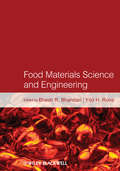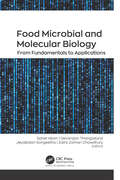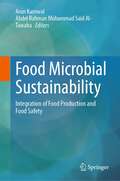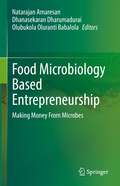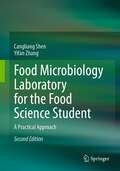- Table View
- List View
Food Materials Science and Engineering
by Bhesh BhandariFood Materials Science and Engineering covers a comprehensive range of topics in relation to food materials, their properties and characterisation techniques, thus offering a new approach to understanding food production and quality control. The opening chapter will define the scope and application of food materials science, explaining the relationship between raw material structure and processing and quality in the final product. Subsequent chapters will examine the structure of food materials and how they relate to quality, sensory perception, processing attributes and nutrient delivery. The authors also address applications of nanotechnology to food and packaging science. Methods of manufacturing food systems with improved shelf-life and quality attributes will be highlighted in the book.
Food Materials Science and Engineering
by Bhesh BhandariFood Materials Science and Engineering covers a comprehensive range of topics in relation to food materials, their properties and characterisation techniques, thus offering a new approach to understanding food production and quality control. The opening chapter will define the scope and application of food materials science, explaining the relationship between raw material structure and processing and quality in the final product. Subsequent chapters will examine the structure of food materials and how they relate to quality, sensory perception, processing attributes and nutrient delivery. The authors also address applications of nanotechnology to food and packaging science. Methods of manufacturing food systems with improved shelf-life and quality attributes will be highlighted in the book.
Food, Media and Contemporary Culture: The Edible Image
by Peri BradleyFood, Media and Contemporary Culture is designed to interrogate the cultural fascination with food as the focus of a growing number of visual texts that reveal the deep, psychological relationship that each of us has with rituals of preparing, presenting and consuming food and images of food.
Food Microbial and Molecular Biology: From Fundamentals to Applications
by Saher Islam Devarajan Thangadurai Jeyabalan Sangeetha Zaira Zaman ChowdhuryThe ever-increasing globalization of the food industry demands new interventions and prevention technologies to improve the safety and quality of food. This multidisciplinary new book presents advanced systems for identifying, analyzing, tracking, and monitoring microbial contaminants in food.Key features:• Highlights emerging and re-emerging foodborne microorganisms and their virulence characteristics• Includes recent approaches for food quality assurance and risk management• Describes the practicality of molecular biology and microbial technologies for effectual control of foodborne infections• Presents a detailed overview of the utilization of recent molecular techniques in food microbiologyWith expert contributions from experienced academics involved in food microbiology and molecular biology research, this book offers indispensable guidance and a contemporary update of the latest developments in food microbial and molecular biology.
Food Microbial and Molecular Biology: From Fundamentals to Applications
by Saher Islam Devarajan Thangadurai Jeyabalan Sangeetha Zaira Zaman ChowdhuryThe ever-increasing globalization of the food industry demands new interventions and prevention technologies to improve the safety and quality of food. This multidisciplinary new book presents advanced systems for identifying, analyzing, tracking, and monitoring microbial contaminants in food.Key features:• Highlights emerging and re-emerging foodborne microorganisms and their virulence characteristics• Includes recent approaches for food quality assurance and risk management• Describes the practicality of molecular biology and microbial technologies for effectual control of foodborne infections• Presents a detailed overview of the utilization of recent molecular techniques in food microbiologyWith expert contributions from experienced academics involved in food microbiology and molecular biology research, this book offers indispensable guidance and a contemporary update of the latest developments in food microbial and molecular biology.
Food Microbial Sustainability: Integration of Food Production and Food Safety
by Arun Karnwal Abdel Rahman Mohammad Said Al-TawahaThis book reviews all important aspects of Microbial sustainability in food production and food safety with the aim of shedding new light on these microbes through combined understanding of traditional and novel paradigms. The book is divided into three sections, the first of which reinterprets fundamentals of food microbiology, examining the beneficial aspects of microorganisms in food and microbial responses from food environments and preservation. The second section discusses recent advances in understanding of the sustainable food production, covering, for example, agriculturally important microbes, farming microbes, and fermentation. A wide range of bio-factory issues in food production are also addressed, before turning attention to contemporary food safety approaches in the context of novel assessment methods for microbiological food characterization, improving food safety and food quality, etc. The final section is devoted to public health and its importance of microorganisms in food processing as well as the economic importance of microorganisms as this is also an increasingly important area as we move toward microbial research advances.
Food Microbiology: Principles into Practice
by Osman Erkmen T. Faruk BozogluThis book covers application of food microbiology principles into food preservation and processing. Main aspects of the food preservation techniques, alternative food preservation techniques, role of microorganisms in food processing and their positive and negative features are covered. Features subjects on mechanism of antimicrobial action of heat, thermal process, mechanisms for microbial control by low temperature, mechanism of food preservation, control of microorganisms and mycotoxin formation by reducing water activity, food preservation by additives and biocontrol, food preservation by modified atmosphere, alternative food processing techniques, and traditional fermented products processing. The book is designed for students in food engineering, health science, food science, agricultural engineering, food technology, nutrition and dietetic, biological sciences and biotechnology fields. It will also be valuable to researchers, teachers and practising food microbiologists as well as anyone interested in different branches of food.
Food Microbiology: Principles into Practice
by Osman Erkmen T. Faruk BozogluThis book covers application of food microbiology principles into food preservation and processing. Main aspects of the food preservation techniques, alternative food preservation techniques, role of microorganisms in food processing and their positive and negative features are covered. Features subjects on mechanism of antimicrobial action of heat, thermal process, mechanisms for microbial control by low temperature, mechanism of food preservation, control of microorganisms and mycotoxin formation by reducing water activity, food preservation by additives and biocontrol, food preservation by modified atmosphere, alternative food processing techniques, and traditional fermented products processing. The book is designed for students in food engineering, health science, food science, agricultural engineering, food technology, nutrition and dietetic, biological sciences and biotechnology fields. It will also be valuable to researchers, teachers and practising food microbiologists as well as anyone interested in different branches of food.
Food Microbiology: In Human Health and Disease
by Nancy KhardoriA broad overview of foodborne infectious diseases, this book covers recent outbreaks, highlighting the food sources and pathogens involved. It also examines foodborne infectious diseases in travelers that are not commonly seen in the United States, outbreak investigation, sources and vehicles of foodborne pathogens as well as diagnosis, treatment,
Food Microbiology and Hygiene
by Richard HayesThe aims of this book remain the same, that is, that it should be of in terest to all those people concerned with, or about, food hygiene in the broadest sense. There was clearly a need for a book of this sort and its success has necessitated a second edition. It will, I hope, answer criticisms that were justifiably made about certain omissions and shortcomings levelled at the earlier edition. The whole book has been thoroughly revised with the introduction of several new sections to various chapters. During the time that has elapsed since the earlier edition appeared there has been much publicity about newer forms of 'food poisoning'. Thus listeriosis is discussed in some detail whilst the problems of salmonellas in eggs and BSE are also considered. Interest in irradiated foods has waxed and waned but it is rightly included in the relevant chapter. There has been much progress in methodology with the advent of advanced molecular techniques such as gene probes and that of PCR; these are discussed briefly. I have included sections on HACCP which has come into great prominence in recent years thus answering a specific criticism made of the earlier edition. The chapter on water and waste disposal contains material on Legionnaires' disease and cryptosporidiosis, infections of much concern at the present time. Finally, the chapter on legislation has undergone a major revision with far greater emphasis being placed on EC food hygiene legislation.
Food Microbiology Based Entrepreneurship: Making Money From Microbes
by Natarajan Amaresan Dhanasekaran Dharumadurai Olubukola Oluranti BabalolaThis book is first part of the 3 volume set focusing on basic and advanced methods for using microbiology as an entrepreneurial venture. This book deals with the concept of entrepreneurship skills for production, cost-benefit analysis and marketing of button, oyster, milky mushroom, Ganoderma sp, Single cell protein, Breads, Cheese, Yoghurt, Wine, Beer, Probiotics, Prebiotics fermented vegetables, and Fermented Fish etc. Chapters cover the applications of microorganisms in small and large scale production to achieve a sustainable output. This book provides essential knowledge and working business protocols from all related disciplines of food and dairy industry, probiotics industry, mushroom industry, beverage and baking industry, poultry industry, and aquaculture industry etc. This book is useful to graduate students, research scholars and postdoctoral fellows, and teachers who belong to different disciplines via botany, food microbiology, biotechnology, aquaculture microbiology and poultry microbiology. The other two volumes are focused on agriculture and industrial microbiology.
Food Microbiology Laboratory (Contemporary Food Science Ser.)
by Lynne McLandsboroughIn order to truly understand food microbiology, it is necessary to have some experience in a laboratory. Food Microbiology Laboratory presents 18 well-tested, student-proven, and thoroughly outlined experiments for use in a one-semester introductory food microbiology course. Based on lab experiments developed for food science and microbiology cours
Food Microbiology Laboratory (Contemporary Food Science Ser.)
by Lynne McLandsboroughIn order to truly understand food microbiology, it is necessary to have some experience in a laboratory. Food Microbiology Laboratory presents 18 well-tested, student-proven, and thoroughly outlined experiments for use in a one-semester introductory food microbiology course. Based on lab experiments developed for food science and microbiology cours
Food Microbiology Laboratory for the Food Science Student: A Practical Approach
by Cangliang Shen Yifan ZhangThis book is designed to give students an understanding of the role of microorganisms in food processing and preservation; the relation of microorganisms to food spoilage, foodborne illness, and intoxication; general food processing and quality control; the role of microorganisms in health promotion; and federal food processing regulations. The listed laboratory exercises are aimed to provide a hands-on-opportunity for the student to practice and observe the principles of food microbiology. Students will be able to familiarize themselves with the techniques used to research, regulate, prevent and control the microorganisms in food and understand the function of beneficial microorganism during food manufacturing process.
Food Microbiology Laboratory for the Food Science Student: A Practical Approach
by Cangliang Shen Yifan ZhangThis book is designed to give students an understanding of the role of microorganisms in food processing and preservation; the relation of microorganisms to food spoilage, foodborne illness, and intoxication; general food processing and quality control; the role of microorganisms in health promotion; and federal food processing regulations. The listed laboratory exercises are aimed to provide a hands-on-opportunity for the student to practice and observe the principles of food microbiology. Students will be able to familiarize themselves with the techniques used to research, regulate, prevent, and control the microorganisms in food and understand the function of beneficial microorganism during food manufacturing process. The second edition add 5 new chapters including “Chapter 10 -Thermal inactivation of Escherichia coli O157:H7 in mechanically tenderized beef steaks and color measurements”, “Chapter 11-Evaluate antimicrobial activity of chlorine water on apples and measurement of free chlorine concentrations”, “Chapter 12-Evaluate cross-contamination of Salmonella on tomatoes in wash water using most probable number (MPN) technique”, “Chapter 15-DNA extraction and purity determination of foodborne pathogens”, and “Chapter 16-Practice of multiplex PCR to identify bacteria in bacterial solutions”. It also includes new lab work flowcharts for Gram-staining and endospore-staining technology in Chapter 1, pour plating and spread plating in Chapter 3, Enterotube II in Chapter 9, and Kirby Beau test procedure in Chapter 20. It includes a new sample of syllabus with the hybrid teaching of both lecture and lab sections in one course, which will assist junior faculty/instructors to develop similar lecture and lab courses.
Food Mixing: Principles and Applications
by P. J. CullenThe mixing of liquids, solids and gases is one of the most common unit operations in the food industry. Mixing increases the homogeneity of a system by reducing non-uniformity or gradients in composition, properties or temperature. Secondary objectives of mixing include control of rates of heat and mass transfer, reactions and structural changes. In food processing applications, additional mixing challenges include sanitary design, complex rheology, desire for continuous processing and the effects of mixing on final product texture and sensory profiles. Mixing ensures delivery of a product with constant properties. For example, consumers expect all containers of soups, breakfast cereals, fruit mixes, etc to contain the same amount of each ingredient. If mixing fails to achieve the required product yield, quality, organoleptic or functional attributes, production costs may increase significantly. This volume brings together essential information on the principles and applications of mixing within food processing. While there are a number of creditable references covering general mixing, such publications tend to be aimed at the chemical industry and so topics specific to food applications are often neglected. Chapters address the underlying principles of mixing, equipment design, novel monitoring techniques and the numerical techniques available to advance the scientific understanding of food mixing. Food mixing applications are described in detail. The book will be useful for engineers and scientists who need to specify and select mixing equipment for specific processing applications and will assist with the identification and solving of the wide range of mixing problems that occur in the food, pharmaceutical and bioprocessing industries. It will also be of interest to those who teach, study and research food science and food engineering.
Food Molecular Microbiology (Food Biology Series)
by Spiros Paramithiotis Jayanta Kumar PatraWith the advances in the field of molecular biology, new tools make it possible to conduct in-depth studies in food microbial communities from a molecular perspective. Information from genomic, transcriptomic, proteomic and metabolomic studies can be integrated through bioinformatic applications, thereby improving our understanding of the interactions between biotic and abiotic factors and concomitantly the physiology of starter cultures, spoilage and pathogenic microbiota. Improvements in the speed, accuracy and reliability of food quality and safety assessment have made the foundation stronger for future developments including the exploitation of gene networks and applications of nanotechnology and systems biology. This book reviews all these developments, provides an integrated view of the subject and helps in identifying areas of future development.
Food Molecular Microbiology (Food Biology Series)
by Spiros Paramithiotis Jayanta Kumar PatraWith the advances in the field of molecular biology, new tools make it possible to conduct in-depth studies in food microbial communities from a molecular perspective. Information from genomic, transcriptomic, proteomic and metabolomic studies can be integrated through bioinformatic applications, thereby improving our understanding of the interactions between biotic and abiotic factors and concomitantly the physiology of starter cultures, spoilage and pathogenic microbiota. Improvements in the speed, accuracy and reliability of food quality and safety assessment have made the foundation stronger for future developments including the exploitation of gene networks and applications of nanotechnology and systems biology. This book reviews all these developments, provides an integrated view of the subject and helps in identifying areas of future development.
Food Nanoscience and Nanotechnology (Food Engineering Series)
by Humberto Hernández-Sánchez Gustavo Fidel Gutiérrez-LópezNanoscience and nanotechnology have had a great impact on the food industry. They have increased the nutritional and functional properties of a number of food products and have aided in food preservation through the addition of antimicrobials or the reduction of water activity. These and many other applications have emerged in recent years to transform food science and technology. This book proposes to look at some of these applications and their effect on food production and innovation.
Food Nanotechnology: Principles and Applications (Contemporary Food Engineering)
by C. Anandharamakrishnan S. ParthasarathiNanotechnology offers great potential to revolutionize conventional food science and the food industry. The use of nanotechnology in the food industry promises improved taste, flavor, color, texture, and consistency of foodstuffs and increased absorption and bioavailability of nutraceuticals. Food Nanotechnology: Principles and Applications examines the current state of nanoscale phenomena and processes, benefits and risks of nanotechnology. This work contains 18 chapters particularly focused on the design, production, and utilization of nanoparticles, with specific applications for the food industry. Through several studies, it has been proven that nanotechnology can offer distinct advantages over conventional methods in terms of functionality, targeted delivery of food bioactive compounds, improved food quality characteristics like texture, taste, sensory attributes and improved stability in the gastrointestinal tract, and controlled release profiles. Features Offers clear and concise coverage on application of nanotechnology in nutrient delivery, food packaging, and pathogen/pesticide detection Addresses both the technological aspects of delivering nano-based food products and the societal implications that affect take-up Covers broad range of topics including nanoemulsification, electrospraying, nanocomposites, plasma processing, and nanosensors Discusses different formulation and preparation methods for loading food bioactive compounds Exploratory in nature, this book presents the latest of such data on all aspects of applications of nanotechnology in food systems. With its practical focus on the fabrication and application of nanotechnology in food, this book is a valuable resource for students, researchers, food process engineers.
Food Nanotechnology: Principles and Applications (Contemporary Food Engineering)
by C. Anandharamakrishnan S. ParthasarathiNanotechnology offers great potential to revolutionize conventional food science and the food industry. The use of nanotechnology in the food industry promises improved taste, flavor, color, texture, and consistency of foodstuffs and increased absorption and bioavailability of nutraceuticals. Food Nanotechnology: Principles and Applications examines the current state of nanoscale phenomena and processes, benefits and risks of nanotechnology. This work contains 18 chapters particularly focused on the design, production, and utilization of nanoparticles, with specific applications for the food industry. Through several studies, it has been proven that nanotechnology can offer distinct advantages over conventional methods in terms of functionality, targeted delivery of food bioactive compounds, improved food quality characteristics like texture, taste, sensory attributes and improved stability in the gastrointestinal tract, and controlled release profiles. Features Offers clear and concise coverage on application of nanotechnology in nutrient delivery, food packaging, and pathogen/pesticide detection Addresses both the technological aspects of delivering nano-based food products and the societal implications that affect take-up Covers broad range of topics including nanoemulsification, electrospraying, nanocomposites, plasma processing, and nanosensors Discusses different formulation and preparation methods for loading food bioactive compounds Exploratory in nature, this book presents the latest of such data on all aspects of applications of nanotechnology in food systems. With its practical focus on the fabrication and application of nanotechnology in food, this book is a valuable resource for students, researchers, food process engineers.
Food Nutrition and Health
by Fergus M. Clydesdale Frederick J. FrancisDramatic cultural changes have occurred in the areas of food, nutri tion, and health in the United States. Today, the clarion call is for fitness with "trim-muscular" in and "skinny-pale" out. The "me generation" has turned into a robust health seeking "we generation," with emphasis on group participation in an ever-increasing array of health clubs. Com bined with this renewed interest in fitness is an increasing acceptance of technology, which has resulted in the expectation of a high quality of life through the use of technology rather than through its banishment as was the case in the late 1960s and 1970s. Thus, we see the use of indi vidualized computer programs for diet, exercise, and improvement of athletic performance through motion analysis of the event. Aging has become an accepted phenomenon and the long fruitless search for perpetual youth seems over. Old is beautiful as long as it is associated with the trim and robust look of other age groups. This is due to the changing demographics of the United States, as well as recogni tion of the simple fact that age is not a drawback in achievement levels in most areas of our society. These changes, which are in many respects the antithesis of the beliefs of the 1970s have led us to write this book. We are going to attempt to use the same style of communication we used in our previous book, "Food, Nutrition, and You" but the focus and content is quite different.
Food Nutrition, Science and Technology
by Neelam Singh I. S. SinghThis book explores the nexus of science, technology and nutrition that shapes the way we produce, consume and experience food. It discusses the innovations and principles driving the future of nourishment. The latest scientific information on food nutrition, science and technology are compiled for a better understanding of each division. Print edition not for sale in South Asia (India, Sri Lanka, Nepal, Bangladesh, Pakistan and Bhutan)
Food Nutrition, Science and Technology
by Neelam Singh I. S. SinghThis book explores the nexus of science, technology and nutrition that shapes the way we produce, consume and experience food. It discusses the innovations and principles driving the future of nourishment. The latest scientific information on food nutrition, science and technology are compiled for a better understanding of each division. Print edition not for sale in South Asia (India, Sri Lanka, Nepal, Bangladesh, Pakistan and Bhutan)
Food Oils and Fats: Technology, Utilization and Nutrition
by H.W. LawsonThis is a basic reference/textbook for professionals and students involved with these important oils and fats. It is a valuable source of information for those preparing for or already professionally as sociated with the Food Processing and Foodservice industries. Chapters one through six deal with the technology of oils and fats, including sources, chemical structure, physical and chemical properties, and processing techniques. Chapters seven through twelve are devoted to the utilization of oils and fats in Food Manufacturing and Foodservice, including deep frying, griddling, baking of all types, salad dressings, margarines, hard butters, and dairy product re placements. The last four chapters contain a most complete and up to-date treatment of nutrition, as well as the latest developments in analytical methods, flavor, and product development as they relate to oils and fats. This book contains the necessary information for an understand ing of how oils and fats are used in the food industry and how this information is used to set standards and meet performance goals. In a thoroughly readable way it is a how-to-do, hands-on treatise on using oils and fats for every major food use. ix Acknowledgments I gratefully acknowledge many friends at Procter & Gamble who provided updated material, some currently employed and some re cently retired. Fred J. Baur, formerly of Procter & Gamble, wrote the updated chapters related to Analytical Methods, Flavor, Nutri tion, and Dietary Considerations.
